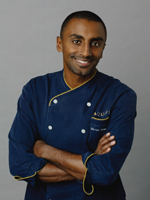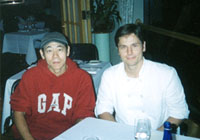Ringo Bites the Big Apple
Back to Contents of Issue: February 2004
|
|
|
|
by Celia Farber |
|
|
How about this: a top Japanese American restaurant run by a star chef who came to Japanese cuisine by way of Sweden and, of all places, Ethiopia?
Marcus Samuelsson is known as the man who forged not only a consciousness but a real passion for Scandinavian cuisine in New York City. Samuelsson is head chef for Hakan Swahn's internationally renowned Aquavit where 100,000 people dine each year. "Aquavit" -- the iconic Scandinavian liqueur for which the venue is named -- is stored in giant jugs on the bar, its flavoring fruits and herbs tumbling mysteriously inside.
As in Japanese cuisine, Swedish food is all a matter of sharp, contrasting yet somehow synchronous tastes.
Aquavit's superstar chef, the Ethiopian-born Samuelsson, is launching on a nationwide US tour to promote his new book: Aquavit and the New Scandinavian Cuisine. Before he leaves, he explains to me that he sees the world's cultures melting into each other, a result of his many years spent as a chef aboard cruise ships traveling the world. "The modern person today is less bound to country, and more bound to vibe, feel, passion -- all the different cultures that stem from the streets," he says.
During his years at sea, Samuelsson worked alongside chefs from numerous cultural backgrounds, but none impressed him more than the Japanese, with their discipline and what he calls their "respect for their knives. There's a mystique around these guys. They're doing something different."
Johan Svensson and Shigenori Tanaka, both humble but hotly burning stars in New York's culinary galaxy, put the finishing touches on the trio's new restaurant, the heavily anticipated Riingo. Riingo is the realization of Samuelsson's longtime dream to open a Japanese restaurant of his own.
"The simplicity, the focus, the hard work and the ethics [of the Japanese] -- that's what attracts me," Samuelsson explains. "A directness in the food culture: We serve, you eat. Boom! It's intimate; a totally different paradigm of cooking than the Western one."
I'm sitting at a blond wood table in Aquavit's soaring atrium, which was once part of a converted townhouse owned by Nelson Rockefeller. I am flanked by Svensson and Tanaka, the two chefs who will be handling most of the cooking at Riingo. The former will handle the Japanese-inspired, but ultimately "American" hot foods, and the latter will make the sushi. Our subject is fish, and quite by accident I stumble upon a revelation.
Tanaka's English is a little rough so he uses a lot of body theatrics to illustrate his points. At one point he makes a gesture of a man holding a fishing pole and pulling a fish out of the water. "In Japan," he says. "It's one fish at a time."
"Just by throwing a fish to the deck of the boat, you destroy it," explains Svensson, and Tanaka nods. "If you want high quality sushi, you have to have high quality fish."
Imagine telling an American fish supplier that they have to treat each fish like a rare jewel. Americans think of everything in terms of bulk, size and speed -- and don't tend to value things that require deep attentiveness, certainly not in the realm of food production. But listening to Tanaka, I'm getting an exhilarating whiff of Japan -- a country that suddenly seems on everybody's mind.
They know Tanaka well at the Apollo fish supplier in Queens, where fish is flown in exclusively from Japan every day and shipped to those few select sushi chefs whose tastes are well known by the man who runs it, Nobuaki Ishida. With eyes as clear as glass and sparkling bright bodies, these fish, and their gentle, patient fishermen on the other side of the world, are the real reason it takes months to get a reservation at Soho's perennially packed Nobu: the intimacy between fisherman and fish.
Now Riingo, with Tanaka, Samuelsson and Svensson at the helm, is poised to become a formidable contender.
For those who don't want sushi or other Japanese foods, Riingo will offer a Western menu. The three chefs see this new hybrid as the element giving them an edge on the massive competition. But they don't have to hustle hard for an edge: They already have practically everything going for them.
Tanaka was handpicked like a jewel from the tiny exclusive Lower East Side sushi restaurant called Jewel Bako. Samuelsson has won virtually every culinary prize and four-star review there is to win. Riingo boasts flawless decor and an address in the brand new and very chic Alex Hotel in midtown.
"Most Japanese restaurants here are actually American style," Tanaka says, frowning slightly.
Svensson interjects. "In their eagerness to please the American palette," he says in his barely detectable Swedish accent, "they have gotten too creative. Too busy. Caviar, mayo, all these sauces on the rolls." He shakes his head. "In Japan the cuisine is cleaner. I don't think you can find a dragon roll in Japan. That's what we want to replicate at Riingo. An authentic Japanese experience, where the food speaks for itself."
Svensson's comments strike me, a half-Swede, as very Swedish. Svensson reads my mind: "Japan and Sweden actually have a lot in common, as cultures," he says. "The understatement. The clarity of lines. The simplicity."
But Sweden has raw fish customs so weird they require you to be stone cold drunk on Aquavit to get the stuff past your gag reflex. I ask Tanaka about Surstromming.
He looks puzzled. "It's a fermented fish," Svensson says carefully. Let's not beat around the bush, I interject. It wouln't be inaccurate to call it "rotten."
"It comes in these cans that swell up from the fermentation," Svensson says, gesturing with his hands. "And when you buy them they look like footballs."
Tanaka shifts uneasily in his seat. "It's illegal in every country except Sweden, because it stinks so bad it makes people deranged," I tell him. "But they have an elaborate ritual around Surstromming every September. They eat it with potatoes and schnapps. And they sing dozens of songs as they fall off their chairs, literally stinking drunk."
"Does it taste good?" Tanaka asks.
"I've never tried it," Svensson says quietly.
"I have," I say proudly. "It tastes better than it smells. That's about the best you can say about it. It's a kind of masochistic ritual to eat it. Though some Swedes swear by it."
My mother, who was Swedish, was a flight attendant back in the 60s. She loved Surstromming and was constantly trying to smuggle cans of it out of the country. Once she dumped a can in a garbage bin at an airport in Karachi. It exploded, and they thought the sewage pipes had burst so they shut down the whole airport.
Tanaka's facial expression borders on pain and he shakes his head. But as a kind of concession to incomprehensible native fish rituals in Europe, our conversation naturally turns to blowfish -- the exotically poisonous delicacy served up in Tanaka's homeland.
The Japanese chef calmly explains how diners sign waivers relinquishing the right to take legal action if they are poisoned by the pricey fish. But he assures us that only a few per year are unlucky enough to get a lethal blowfish. "If they're cut right," he laconically notes, "it's no problem."
Spoken like a true sushi genius. @
|
|
Note: The function "email this page" is currently not supported for this page.


 New restaurants in New York have to fight hard to be noticed, or be touched by a special glitter, or have the right names attached -- or just be damn good. There are over 51,000 restaurants in the state of New York, and each wants to penetrate the consciousness in some way that transcends food. But how many times can you see that same photograph of the small pile of crispy brown grass atop a delectable rondelle of food, or the green gel squiggled across a gleaming white plate, and still get excited?
New restaurants in New York have to fight hard to be noticed, or be touched by a special glitter, or have the right names attached -- or just be damn good. There are over 51,000 restaurants in the state of New York, and each wants to penetrate the consciousness in some way that transcends food. But how many times can you see that same photograph of the small pile of crispy brown grass atop a delectable rondelle of food, or the green gel squiggled across a gleaming white plate, and still get excited?
 Tanaka laughs, adjusting his baseball cap, and I feel like I've been inducted into a rarified secret. Tanaka explains that in Japan, even fishing is an art, and the real fishermen, who supply a handful of top sushi chefs in New York, pull up their fish one by one. They then follow a very careful procedure in each subsequent step, from taking the fish off the hook, to placing it on ice, to shipping it to its next destination -- which is a Japanese fish dealer in Queens who has all the quiet mystique of a drug dealer. Never, never would you allow one fish to touch another, and the concept of throwing a fish is unthinkable.
Tanaka laughs, adjusting his baseball cap, and I feel like I've been inducted into a rarified secret. Tanaka explains that in Japan, even fishing is an art, and the real fishermen, who supply a handful of top sushi chefs in New York, pull up their fish one by one. They then follow a very careful procedure in each subsequent step, from taking the fish off the hook, to placing it on ice, to shipping it to its next destination -- which is a Japanese fish dealer in Queens who has all the quiet mystique of a drug dealer. Never, never would you allow one fish to touch another, and the concept of throwing a fish is unthinkable.



